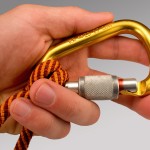How to Take Care of Your Climbing Rope
 Although the climbing ropes of today are more resilient than ever, some containing protection against UV rays, chemical, and even misuse, taking care of your rope is still as important as ever. The climbing rope is one of the climber’s most valuable possessions and many times his life actually rests in its hands. Not only is it good sportsmanship to take good care of your climbing rope, it just might save your life.
Although the climbing ropes of today are more resilient than ever, some containing protection against UV rays, chemical, and even misuse, taking care of your rope is still as important as ever. The climbing rope is one of the climber’s most valuable possessions and many times his life actually rests in its hands. Not only is it good sportsmanship to take good care of your climbing rope, it just might save your life.
One of the most important ways of taking good care of your climbing rope is to pay attention to how it is left when you are not using it. Your rope will have a lot more down time than use and, if not stored properly, its down time could be its downfall. Your climbing rope should always remain coiled when out of use, and make sure that coil is free of kinks, knots, and twists which can severely damage the integrity of a rope if left for too long. Buying a good quality bag to keep your rope in will help it to remain free of harmful dust and dirt particles and increase its overall lifespan. Special kinds of rope bags are available which can fold out into a large tarp where your rope can sit happily sheltered from the earth and then fold back in to a compact little carrying case with a shoulder or backpack strap.
Try not to leave your rope in harsh sunlight for too long. Even if it comes with UV protection, don’t underestimate the sun. Whether you throw your rope on the porch after a long day’s climb, toss it into the back of your car beside an open window, or even just leave it sitting in an exposed place at your climbing site for too long, these things can do serious damage to your rope as the sun eats away at its fibers. It’s better to be safe and keep your climbing rope in the shade.
You’ve probably heard that you shouldn’t step on your rope and, while this is true in a general sense, simply stepping on your rope will not snap it in two. Although it is a good rope care tip to try to avoid continual treading on the rope, many people become obsessive about this point and go to extremes about it, even becoming angry and aggressive with any unfortunate who may have made one careless misstep. This can ruin the best climbing trip to the highest mountain in the freshest weather. It’s better to try to keep your rope away from places where people might step and, if necessary, announce your preference to the other climbers before they have a chance to accidentally do something that may incur your wrath. Stepping on a rope will put it into contact with all sorts of tiny yet nasty dirt and rock particles which may in time speed up its process of deterioration. For this reason it’s best to take steps to avoid doing it, but keep in mind that it’s not the end of world.
If you have fallen on your rope repeatedly, you may want to temporarily retire it or at least switch ends. Although climbing ropes were made for falling on, it will stretch them out for a while and cause that end to become temporarily less elastic. Give the end you fell with a little rest so it can regain its elasticity; coil it up securely and use the other end to lead with for a while.
Just like anything else that is exposed to mountains of dirt, when your climbing rope gets soiled, you’re allowed to wash it. Washing it will not wear it down excessively and may even increase its lifespan by removing harmful and abrasive dirt particles and rocks from its fibers. When your rope gets too dirty, stuff it into a mesh bag and toss it in the washing machine. Use a long cycle with cold water and a very gentle, non-detergent laundry soap. But don’t hang it up on the laundry lines to dry—remember those harmful ultraviolet rays. Give it a few days in a dark, cool place to dry out and your rope will be its best, cleanest self in no time at all.
